Knowing how to check refrigerant level in AC is critical to ensure your air conditioning unit cools efficiently and lasts longer. This simple guide will help you identify if you have a refrigerant issue and show you how to check the levels yourself.
Key Takeaways
- Maintaining proper refrigerant levels is crucial for optimal AC performance, energy efficiency, and longevity, as low levels can lead to costly damage to your ac unit will contributing to higher energy costs in your monthly electric bill.
- Common signs of low refrigerant levels include warm air from vents, ice buildup on the evaporator coil, and unusual hissing noises, all indicating potential leaks that need to be addressed promptly.
- To check refrigerant levels, gather tools like a refrigerant pressure gauge, turn off the AC, and follow a step-by-step process to safely assess and adjust refrigerant levels as needed.
Why Proper Refrigerant Levels Matter
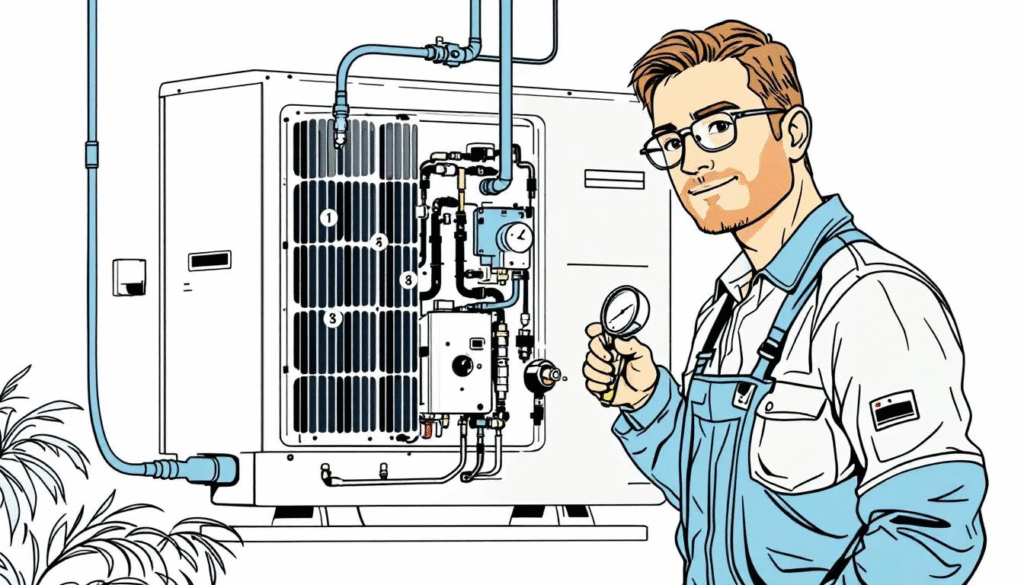
Maintaining proper refrigerant levels ensures your air conditioning system performs optimally. They also contribute to energy efficiency and the longevity of the unit. Low refrigerant levels can lead to inefficient cooling performance and increased humidity in your home, making your living space uncomfortable. Moreover, when refrigerant levels drop, the system has to work harder to achieve the desired temperature, which increases energy consumption and costs.
In the long run, operating with insufficient refrigerant can cause significant damage to critical components like the compressor, resulting in costly repairs. Using the correct type and amount of refrigerant impacts the overall performance of the AC unit.
Regular maintenance, such as professional inspections and filter changes, keeps refrigerant levels in check, prevents unexpected breakdowns, and promotes efficient, long-lasting system operation.
Common Signs of Low Refrigerant Levels
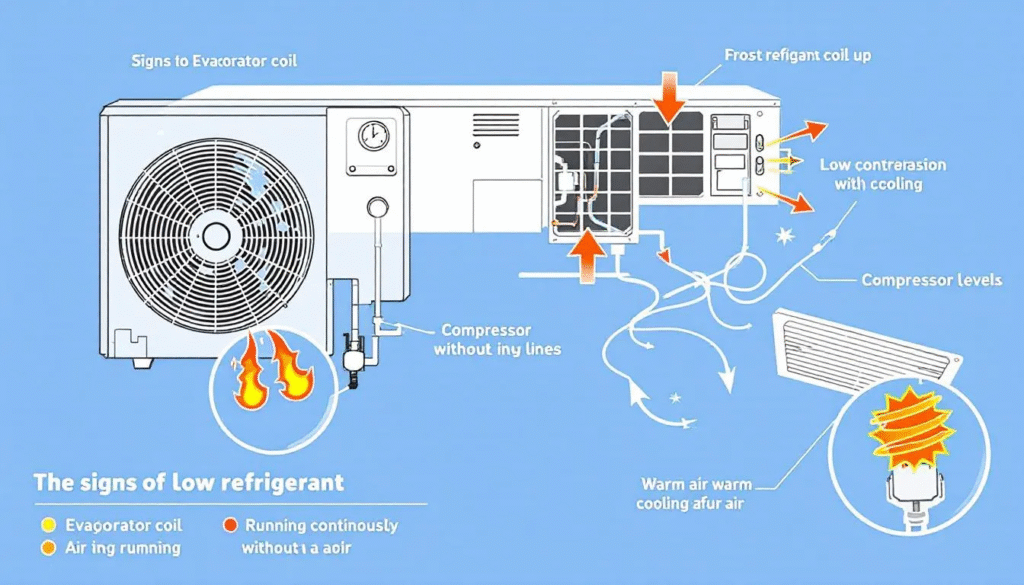
Low refrigerant levels in your air conditioning system can manifest through various telltale signs, including low levels of refrigerant. Recognizing these early can help you address the issue before it leads to more severe damage. Common indicators include warm air blowing from the vents, ice buildup on the evaporator coil, and unusual hissing or bubbling noises.
Since refrigerant does not naturally deplete, these signs often point to a leak in the system. Addressing these issues promptly helps maintain your AC unit’s efficiency.
Warm Air from Vents
Warm air blowing from your home air conditioner can indicate low refrigerant levels. This can be particularly frustrating during hot air weather when you rely on your AC to keep your home comfortable. Symptoms like short-cycling, where the AC frequently turns on and off, also suggest low refrigerant levels. Warm air coming from the vents signals that the system is struggling to achieve the desired cooling effect, leading to increased energy bills and reduced comfort.
Promptly addressing low refrigerant signs restores your AC system’s efficiency and extends its lifespan. Proper refrigerant levels maintain your AC system’s efficiency and longevity, ensuring consistent cool air and a comfortable indoor temperature.
Ice Buildup on Evaporator Coil
Another clear sign of low refrigerant levels is ice buildup on the evaporator coil. When there is insufficient refrigerant, the evaporator coil can get too cold, causing moisture in the air to freeze on the coil. This not only decreases the cooling capacity of your air conditioner but can also lead to further mechanical issues. Ice accumulation restricts airflow and can exacerbate the problem, potentially leading to a complete system shutdown.
Observing ice on the evaporator coil requires immediate attention to prevent further damage. Maintaining proper refrigerant levels prevents ice buildup and ensures efficient operation of your air conditioning system.
Hissing or Bubbling Noises
Hearing hissing or bubbling noises from your air conditioner is a telltale sign of a refrigerant leak. These sounds occur because the refrigerant is escaping from the system, which can lead to low refrigerant levels if not addressed. Unusual noises should prompt you to check for leaks and take corrective action to prevent further issues.
Tools You Need to Check Refrigerant Levels
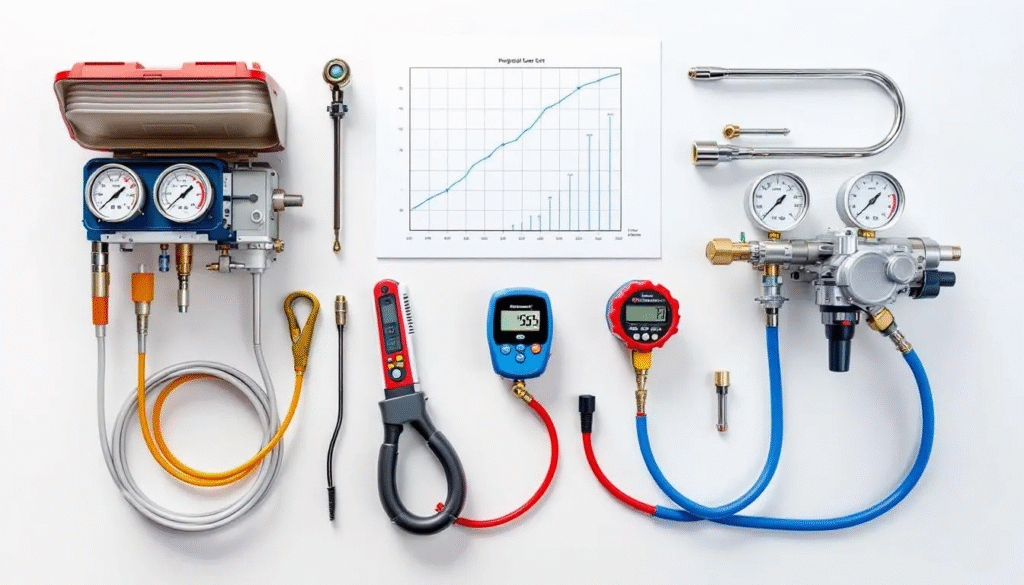
To check refrigerant levels in your air conditioning system, you’ll need a few essential tools. A refrigerant pressure gauge is crucial for measuring the levels accurately. Manifold gauge sets, which include both high-pressure and low-pressure gauges, are commonly used for this purpose. These tools allow you to attach to the refrigerant lines and obtain precise readings.
Safety is critical when handling refrigerant. Always turn off the AC unit before beginning the check to avoid any accidents. Use the right tools and follow safety protocols to accurately and safely assess your refrigerant levels.
Step-by-Step Guide to Checking Refrigerant Levels
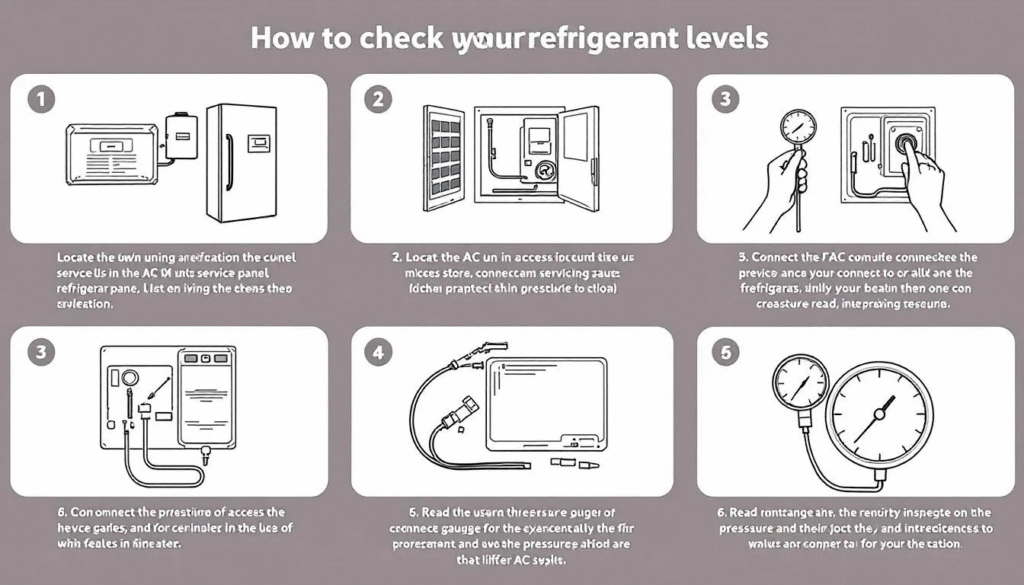
Checking the refrigerant levels in your AC unit is a straightforward process when you have the right tools and knowledge. This step-by-step guide will help you through the process:
- Gather the necessary tools and equipment.
- Locate the service ports on your AC unit.
- Connect the gauges to the service ports.
- Read the pressure levels on the gauges.
- Compare the readings to the manufacturer’s recommended levels.
- Add refrigerant if the levels are low, following safety guidelines.
- Disconnect the gauges and ensure all connections are secure.
Following these steps will help you maintain proper refrigerant levels and keep your AC system running efficiently. Monitoring the refrigerant level is essential for optimal performance.
Turn Off the AC Unit
Begin by switching off the power to the AC unit at the circuit breaker. This step is crucial for your safety before you start the refrigerant check.
Once the unit is off, remove the cover to access the gauge and prepare for the next steps.
Attach Manifold Gauges
Use manifold gauges to check refrigerant levels by following these steps:
- Attach the red gauge to the high-pressure service valve.
- Attach the blue gauge to the low-pressure service valve.
- Ensure these connections are secure to get accurate readings from the manifold gauges.
Attaching the manifold gauges correctly ensures accurate pressure readings. This ensures that you can determine whether the refrigerant levels are adequate or if you need to take further action.
Interpret Pressure Readings
Interpreting the pressure readings from the manifold gauges is crucial to determine if the refrigerant levels are sufficient. Low-pressure readings can indicate low refrigerant levels, while high-pressure readings might suggest too much refrigerant or restricted airflow.
Pressure readings offer valuable insights into your AC unit’s efficiency and performance. These readings help determine if additional refrigerant is needed or if other issues require attention.
What to Do If Refrigerant Levels Are Low
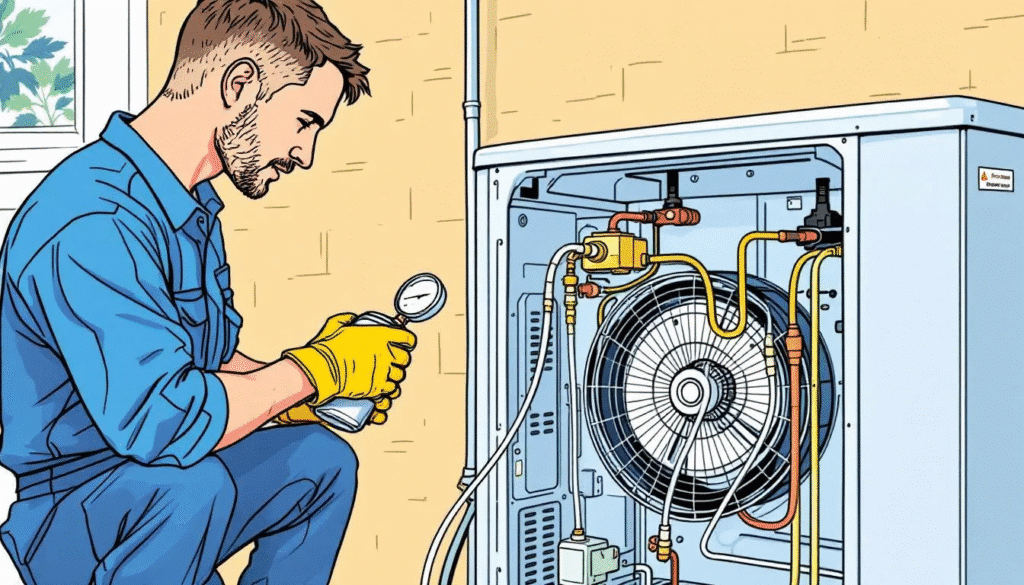
Discovering low refrigerant levels calls for immediate action to prevent further issues. Low refrigerant can cause the evaporator coil to freeze, leading to operational failures in your AC unit.
You can either add refrigerant yourself or contact an HVAC technician for professional assistance.
Add Refrigerant Safely
To add refrigerant yourself:
- Start the AC unit and let it run for a few minutes.
- Locate the service port for recharging refrigerant along the larger of the two copper lines to the compressor.
- Add refrigerant slowly while checking the pressure.
- Note that low-pressure readings may indicate the need to add more refrigerant.
To safely handle refrigerant after adding it:
- Secure all connections.
- Disconnect the charging hose and gauge once the process is complete.
- Use safety equipment like gloves and goggles when handling refrigerant.
Contact an HVAC Technician
If unsure about handling refrigerant or suspecting a leak, contact an HVAC technician. Professionals use tools like electronic leak detectors to identify hidden refrigerant leaks and ensure proper handling of the refrigerant line freon gas refrigerants system.
This ensures safety and accurate troubleshooting, preventing additional issues.
Preventive Maintenance Tips for Your AC System
Preventive maintenance is key to keeping your AC system running efficiently and avoiding issues like low refrigerant levels. Regular inspections can help detect and address refrigerant leaks effectively, enhancing the longevity and efficiency of your AC system.
Regularly Change Filters
Regularly changing filters maintains optimal performance, airflow, and efficiency in your AC system and air conditioning systems. Clean filters ensure efficient system operation, preventing strain on the unit and reducing energy costs.
This easy maintenance task significantly boosts indoor air quality by trapping human pollutants.
Schedule Professional Inspections
Scheduling regular inspections by certified HVAC professionals maintains system efficiency. These inspections identify and catch issues early, preventing costly repairs and ensuring optimal system efficiency.
Habitual scheduling of inspections leads to better long-term performance of your air conditioning system. Early problem detection ensures HVAC systems run smoothly and efficiently.
Summary
Maintaining proper refrigerant levels is essential for the optimal performance, efficiency, and longevity of your air conditioning system. Recognizing signs of low refrigerant levels, such as warm air from vents, ice buildup on the evaporator coil, and unusual noises, can help you address issues promptly. Using the right tools and following a step-by-step guide to check refrigerant levels ensures your AC system runs efficiently.
Taking immediate action when refrigerant levels are low, whether by adding refrigerant safely or contacting an HVAC technician, prevents further damage and operational failures. Regular maintenance, including changing filters and scheduling professional inspections, is vital to avoid issues and maintain the system’s efficiency. By following these guidelines, you can keep your home cool and comfortable all summer long.
Frequently Asked Questions
What are the signs of low refrigerant in my AC system?
Signs of low refrigerant in your AC system include warm air blowing from the vents, ice forming on the evaporator coil, and unusual hissing or bubbling noises. Addressing these issues promptly can help prevent further damage to your system.
How often should I check my AC’s refrigerant levels?
You should check your AC’s refrigerant levels whenever you notice signs of low refrigerant, rather than on a regular schedule. Addressing these signs promptly can help maintain your system’s efficiency.
Can I add refrigerant to my AC system myself?
It is advisable to hire an HVAC technician for adding refrigerant to your AC system, as they ensure accurate and safe handling. Attempting this yourself may lead to improper levels and potential safety hazards.
What tools do I need to check refrigerant levels?
To check refrigerant levels, you will need a refrigerant pressure gauge and a manifold gauge set. These tools will allow you to accurately assess the refrigerant in your system.
How can I prevent low refrigerant levels in my AC system?
To prevent low refrigerant levels in your AC system, prioritize regular maintenance, change filters consistently, and schedule professional inspections. This proactive approach can help ensure efficient operation and extend the life of your unit.



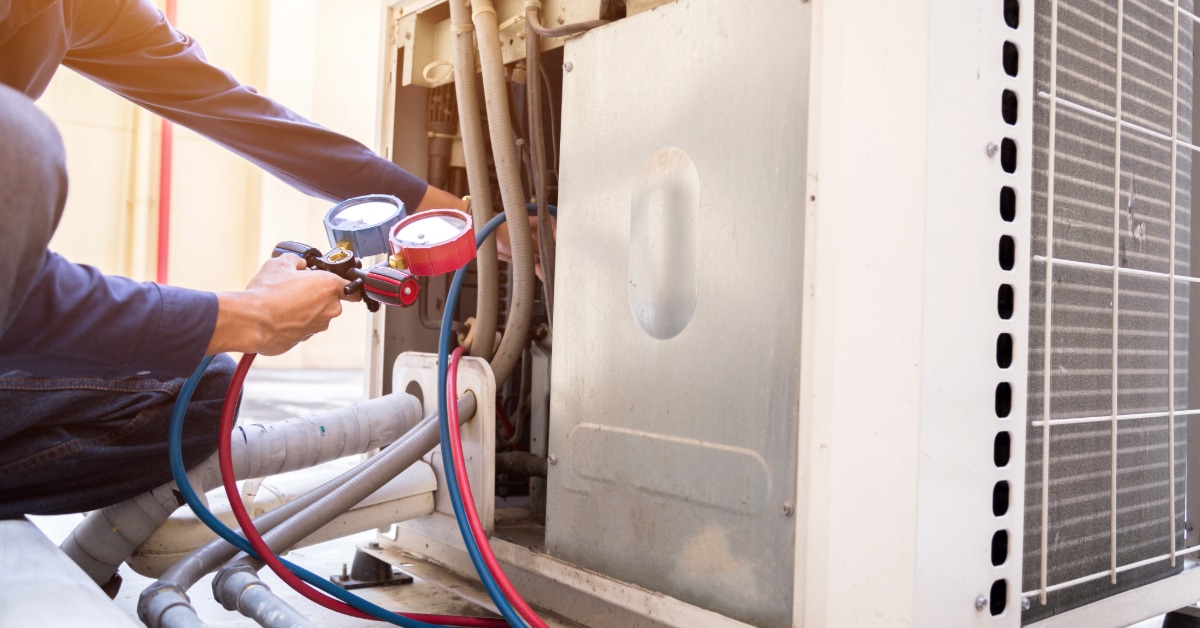
0 Comments